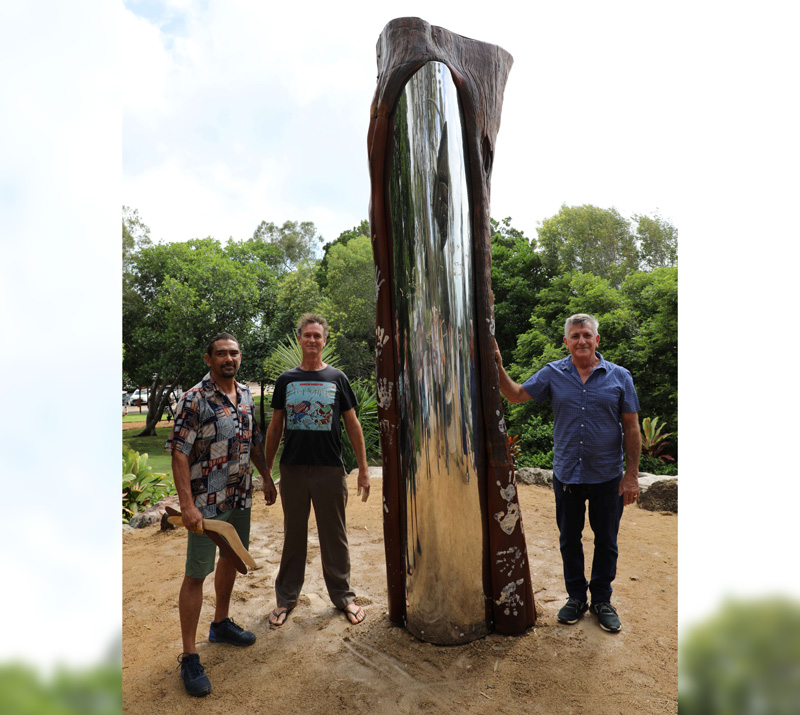Scar tree incorporated into sculpture
Photo: Dunstyn Currie, Ross Bradbury and Chris Calcutt with the Scar Tree
Part of a culturally significant scar tree, or kundu tree, has been incorporated into a sculpture that has been unveiled in Dayman Park at Urangan.
“The scar was created when Butchulla People removed a section of bark to make a kundu (canoe),” Fraser Coast Mayor George Seymour said.
“The tree continued to live and grow for many years after the section of bark was removed.”
Originally the tree grew near the intersection of Booral Road and Boundary Road but was removed by mistake when a footpath was built in the late 1990s.
The trunk was rescued and was stored at the Council’s works depot before being installed in the Bush Tucker section of the Hervey Bay Botanic Garden.
“Unfortunately, the trunk slowly deteriorated in the garden,” Cr Seymour said.
“In 2015 Council was approached by Dustyn Currie who outlined the deep personal significance the tree holds for his family and their connection to the land and ideas to restore the tree.”
Mr Currie had started restoring the trunk while it was still in the garden and began talks with Council on including the trunk as part of the Butchulla interpretive information at Dayman Point.
“Dayman Point is very important to the Butchulla People,” Mr Currie said.
“It was a meeting place and a vantage point from where they could see from Point Vernon down the Sandy Strait. They could see the arrival of turtles, or Diamond scaled mullet and let each other know what was happening.
“When people see the tree, they will be able to appreciate the size of the canoes that were made to fish and hunt.
“They will be able to understand how we lived, fished and interacted with the environment. The removal of the bark did not kill the tree; it continued to live while Butchulla People fished and hunted and lived off the land.
“Dayman Park is a great place to bring together the day-to-day aspects of Butchulla life.”
Mr Currie hopes future interpretive signage around the tree will include the story of the Butchulla connection to the region up to modern era.
“It would be great to have signage that tells of the Butchulla life before European settlement as well as outlining how we shared knowledge with early settlers, especially fishermen, and then worked in the fishing industry,” he said.
The position chosen to install the tree is one of the highest points in the park at the end of a path to a covered seat overlooking the Sandy Strait.
The path was created with the help of Butchulla artists in the early 2000s. Pavers and artwork in the pathway depict fish and animals important to the Butchulla People while holes in the roof over the seat represent stars from the Milky Way.
The scar will face towards Bauple Mountain to link to other culturally significant areas of the region.
“From the tree, visitors will be able to orientate themselves to the region and other important and culturally significant areas within the region,” Mr Currie said.
The work to restore and preserve the trunk has been intricate. The rotting timber was removed, and the remaining tree was freeze dried to prevent further deterioration of the timber.
Fraser Coast artists and craftsmen Ross Bradbury and Glenn Waterman (timber) and Chris Calcutt (stainless steel) were commissioned to incorporate it into a piece of public art to be installed at Dayman Park.
Their previous works include the whale at the Hervey Bay Regional Gallery, the landing boats in the Gallipoli to Armistice Anzac Memorial in Maryborough and the Moah Moah sculpture on the Hervey Bay Esplanade.
The work on the kundu tree included replacing the missing pieces of the three-metre truck.
The scar created when the bark was removed to expose the trunk is now represented by a stainless-steel shell and ironbark planks have been shaped to fill in the gaps where the trunk had rotted away.
